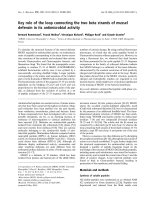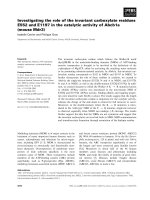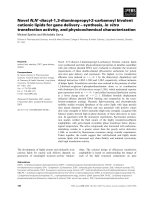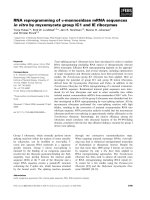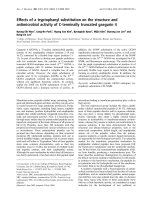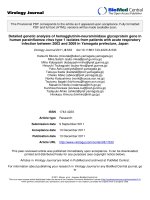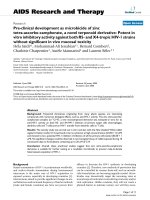In vitro antimicrobial activity of honey and lemon juice mixture against clinical isolates from patients with respiratory tract infections, Bamenda-Cameroon
Bạn đang xem bản rút gọn của tài liệu. Xem và tải ngay bản đầy đủ của tài liệu tại đây (208.06 KB, 9 trang )
Int.J.Curr.Microbiol.App.Sci (2019) 8(2): 35-43
International Journal of Current Microbiology and Applied Sciences
ISSN: 2319-7706 Volume 8 Number 02 (2019)
Journal homepage:
Original Research Article
/>
In vitro Antimicrobial Activity of Honey and Lemon Juice Mixture against
Clinical Isolates from Patients with Respiratory Tract Infections,
Bamenda-Cameroon
Gerald Ngo Teke1*, Flore Nguemaïm Ngoufo1, Alexis Njiki Njiki2
and Henri Lucien Fouamno Kamga2
1
Department of Biomedical Sciences, 2Department of Medical Laboratory Science, Faculty of
Health Sciences, The University of Bamenda, P.O. BOX 39 Bambili, Cameroon
*Corresponding author
ABSTRACT
Keywords
Honey/lemon juice
mixtures, In vitro,
Antimicrobial
activity, Clinical
isolates, BamendaCameroon
Article Info
Accepted:
04 January 2018
Available Online:
10 February 2019
Honey and lemon juice are ingredients used indigenously to treat a number of microbial
infections. Our aim was to study the in vitro antimicrobial activity of honey and lemon
fruit juice mixtures against clinical isolates from patients with respiratory tract infections.
Mixtures of honey and lemon juice were prepared at various proportions (90:10, 75:25,
50:50, 25:75 and 10:90% v/v respectively) and tested for antimicrobial activity against
clinical isolates using agar well diffusion method. MICs and MBCs of the most active test
mixture proportion were determined using broth and agar media respectively.
Cirprofloxacin (for bacteria) and ketoconazole (for yeast) were used as reference
substances. Data were analysed with the help of statistical package for social sciences
(SPSS), version 20. Student Newman-Keuls test was used to compare inhibition diameters.
Generally, the diameter of microbial growth inhibition zones increased with decreasing
proportion of honey in the mixtures. Staphylococcus aureus was most sensitive to the
honey/lemon mixture of 25/75% (v/v) producing a growth inhibitory diameter of 14 mm.
Two test mixture proportions (75/25 and 90/10% v/v) were not able to inhibit the growth
of S. aureus and Streptococcus pyogenes. Candida albicans was susceptible at 25/75%
(8.66 mm) and 10/90% (11.33) test concentrations. The MIC values for S. aureus and S.
pyogene were recorded as 60% concentration of test mixture. C. albicans had a higher
MIC value (80%). All the MBC values for the test microorganisms were considered
greater than 80% of test mixtures. Appropriate mixtures of honey and lemon juice (lemon
50-75% for bacteria and 75-90% for yeast) could be a better alternative treatment against
some infectious diseases.
commonly referred to and is the type of honey
collected by beekeepers and consumed by
humans. There are many species including:
Apis andreniformis, A. florea, A. dorsata, A.
cerana, A. koschevnikovi, A. mellifera, A.
Introduction
Honey is a sweet food made by bees using
nectar from flowers. The variety produced by
honey bees (the genus Apis) is the one most
35
Int.J.Curr.Microbiol.App.Sci (2019) 8(2): 35-43
nigrocincta (Denise et al., 2002). Most
microorganisms do not grow in honey because
of its low water activity of 0.6 (Molan, 1992).
Hydrogen peroxide, methylglyoxal, bee
defensin, pH, osmotic effect as well as
leptosin were known to be responsible for the
antimicrobial effects of honey (Mandal, 2011;
Kato et al., 2012).
mouth was collected at the Microbiology Unit
of the Regional Hospital Bamenda, Cameroon.
Honey and ripen lemon fruits (Citrus limon)
were purchased from the Bamenda food
market. The honey was extracted from
Mbengwi, a subdivision in the same Region of
the North West of Cameroon.
Verification of bacterial isolates from
throat infections
Lemon fruit is an available citrus fruit, popular
for its culinary and medicinal uses. Its fruit
juice consists of about 5% citric acid that
gives to it a sour taste (NPCS, 2012). It is an
important medicinal plant of the family
Rutaceae. It is a rich source of vitamin C and
it is cultivated mainly for its alkaloids, which
are having anticancer activities and the
antibacterial potential in crude extracts of
different parts (viz., leaves, stem, root and
flower) of lemon against clinically significant
bacterial strains has been reported (Kawaii et
al., 2000). Citrus flavonoids have a large
spectrum of biological activity including
antibacterial,
antifungal,
antidiabetic,
anticancer and antiviral activities (Burt, 2004).
There are different varieties of lemon
including: Bush lemon tree, Eureka, Lisbon,
Meyer, Ponderosa, and Variegated pink
(NPCS, 2012). The species Citrus limon was
used in this study. This study was aimed to
determine the antibacterial activity of honey
and lemon juice mixtures on strains of
Staphylococcus
aureus,
Streptococcus
pyogenes and yeast (Candida albicans)
isolated and characterized by standard
microbial procedures from respiratory tract of
patients consulting at the Regional Hospital
Bamenda.
The microbial isolates from mouth and throat
collected at the Microbiology Unit of the
Regional Hospital Bamenda were sub-cultured
on Blood agar and Sabouraud Dextrose agar
for confirmation and were further subjected to
Gram stain techniques, catalase test, coagulase
test and lance field grouping (Cheesbrough,
2006). The bacterial and fungal strains were
grown at 35°C and maintained on nutrient
agar (NA, Conda, Madrid, Spain) and
Sabouraud Dextrose Agar (SDA, Conda)
respectively.
Preparation of honey and lime mixture at
various proportions
The commercial honey obtained from
Bamenda food market was kept in sterile
screwed cap containers and stored at 5°Cin the
Microbiology Laboratory of the Regional
Hospital Bamenda prior to use.
Lemon fruits were obtained from the same
market, washed with tap water and vinegar
and then allowed to air dry. It was sterilized
with 70% alcohol and cut using a knife which
was first sterilized with 70% alcohol and
passed over flame. The lemon juice was
squeezed, filtered using sterile cotton and
glass funnel and placed in a sterile screwed
cap container before refrigerating for later use.
Materials and Methods
Collection of test materials and microbial
samples
The honey and lemon juice were remove from
the fridge and the honey placed in warm water
to bring it to the liquid state. Then both honey
Pure colonies of S. aureus, S. pyogenes and
yeast (C. albicans) isolated from throat and
36
Int.J.Curr.Microbiol.App.Sci (2019) 8(2): 35-43
and lemon juice were allowed on the slap to
attain room temperature. Using a 1000 µl
micropipette, the following five (5) mixtures
were prepared at different proportions of each
substance to a final volume of two milliliters
(2 ml):
Antimicrobial susceptibility testing
The various honey and lime fruit juice
mixtures were tested for antimicrobial
activities using agar disc diffusion technique
to determine the diameter of growth inhibition
zones.
90% (v/v) honey +10%(v/v) lemon juice (900
µl honey+100 µl lemon juice)
75% (v/v) honey + 25% (v/v) lemon juice
(750 µl honey +250 µl lemon juice)
50% (v/v) honey + 50% (v/v) lemon juice
(500 µl honey +500 µl lemon juice)
25% (v/v) honey + 75% (v/v) lemon juice
(250 µl honey +750 µl lemon juice)
10% (v/v) honey + 90%(v/v) lemon juice (100
µl honey +900 µl lemon juice)
Agar disc diffusion test
Briefly, a quantity of 100μl of suspension of
the test microorganisms (prepared as
mentioned above) was spread on Mueller
Hinton agar and Sabouraud dextrose agar
medium respectively for bacteria and yeast.
Prepared filter paper discs such as to
separately absorb 20 μl of the different
concentrations of honey/lemon fruity juice
mixtures (90/10, 75/25, 50/50, 25/75 and
10/90%v/v respectively) were placed on the
seeded plates. This was done using sterile
forceps
under
aseptic
conditions.
Ciprofloxacine (for bacteria) and ketoconazole
(for yeast) were used as reference substances.
Preparation of antimicrobial discs from test
mixtures
Antimicrobial discs of 6mm of diameter were
made using Whattmann filter papern°3. These
discs were sterilized under ultraviolet light for
2hrs then submerged in the test mixtures for
30 minutes (Vineetha et al., 2015) such that
each disc could absorb a quantity of about 20
µl of prepared mixture.
Within 30 minutes of applying the discs, the
culture plates were inverted and incubated
aerobically at 35°C for 24 hours for bacterial
strains and 48 hours for yeast. This was done
for each isolate and each assay in this
experiment was repeated thrice. The diameters
of zones showing complete microbial growth
inhibition by gross visual inspection around
each disc was measured in millimeters using a
transparent meter rule over the back of the
inverted plate and across each disc. A Clinical
and Laboratory Standards Institute (CLSI)
reference chart was used to report microbial
sensitivity as follows: Resistant (0-8mm);
Intermediate (9-13mm); Sensitive (14mm and
above).
Preparation of microbial suspensions
The microbial isolates were first activated by
streaking on nutrient agar and incubating for
24 and 48 hours respectively for bacteria and
yeast. A pipette with a sterile pipette tip was
used to transfer 5 ml of sterile saline distilled
water into labeled sterile plain tubes. A wire
loop was heat flamed, cooled and used to
touch 3 to 5 well isolated similar colonies of
the test organisms from the pure cultures and
emulsified in the sterile saline distilled water
in the labeled sterile plain tubes with each
representing a particular isolate. Each
microbial suspension in test tube was mixed
vigorously, compared visually and adjusted to
the turbidity standard of McFarland 0.5
(Cheesbrough, 2006).
Determination of minimum inhibitory
concentration (MIC) and minimum
bactericidal concentration (MBC)
The broth macrodilution technique was used
for this assay (Barchiesi et al., 1994). This
37
Int.J.Curr.Microbiol.App.Sci (2019) 8(2): 35-43
was done with the proportion of the mixture
which with a majority of higher zones of
microbial growth inhibition. I.e. 25% honey:
75%
(v/v)
lemon
fruit
juice
for
Staphylococcus aureus and Streptococcus
pyogenes; and 10/90% (v/v) for Candida
albicans using broth dilution method. These
mixtures were prepared and considered
mother test samples from which a certain
quantity was obtained (x ml) and transferred
separately into 5 ml test tubes previously
containing Mueller Hinton broth or Sabouraud
dextrose broth (y ml).
sciences (SPSS), version 20. Student
Newman-Keuls test was used to compare
inhibition diameters at different test
concentrations. MICs and MBCs were
expressed as % of honey/lemon fruit juice
mixtures.
Ethical considerations
Ethical clearance was obtained from the
Institutional Review Board of The University
of
Bamenda
(2018/0022/UBa/IRB).
Administrative authorization was obtained
from the Regional Hospital Bamenda.
Freshly prepared microbial suspension (20μl)
was then separately added to the tubes making
a final volume of 3 ml and the test
concentrations were: 0, 20, 40, 60, 80 and
100%. A sterility control tube containing the
test mixture and broth medium but no
microorganisms was equally made. The tubes
were vortexed and incubated at 35°C for 24
hours for bacterial strains and 48 hours for
yeast. The turbidity of each test tube was
visually inspected and compared with the
control (tube with 0% test mixture). The
lowest of the honey/lemon fruit juice mixture
test concentration in clear test tubes was
considered as the MIC (Keizo et al., 2012).
Results
Agar disc diffusion assay
A total of four mixtures at different
proportions of honey and lemon fruit juice
were tested against microbial isolates causing
throat infections: Staphylococcus aureus,
Streptococcus
pyogenes
and
Candida
albicans. Globally, the diameter of microbial
growth inhibition zones increased with
decreasing proportion of honey in the
mixtures. S. aureus was most sensitive to the
mixture of 25/75% (v/v) honey/lemon fruit
juice producing a growth inhibitory diameter
of 14 mm (Fig. 1).
For the MBC determination, all the clear test
tubes indicating no visible sign of microbial
growth or turbidity in the MIC assay, were
further sub-cultured on sterile Mueller Hinton
agar/Sabouraud Dextrose agar plates by streak
plate method.
Two proportions (75/25 and 90/10% (v/v) of
honey/lemon fruit juice mixtures were not able
to inhibit the growth of S. aureus. This similar
situation was observed for S. pyogenes (Fig. 2)
in the presence of the test mixtures.
Then the plates were incubated at 35°C for 24
hours for bacterial strains and 48 hours for
yeast. The least concentration that did not
show growth of test organisms was considered
as the MBC.
The honey and lemon fruit juice mixtures
tested on Candida albicans isolate was active
only at two test concentrations. The smaller
diameter of growth inhibition zone was 8.66
mm at 25% (v/v) honey + 75% (v/v) lemon
juice while the least honey content (10%) in
the mixture gave 11.33 mm inhibition zone
diameter (Fig. 3).
Data management and analysis
Data on inhibition zone diameters were
analysed using statistical package for social
38
Int.J.Curr.Microbiol.App.Sci (2019) 8(2): 35-43
Table.1 Microbial susceptibility, MICs and MBCs of honey and lemon fruit juice mixtures
Microbial
Mean diametera
isolates
value ± SD
Susceptibilityb
Honey-lemon fruit
juice mixture
MIC (%)
MBC (%)
S. aureus
17.33 ± 0.28
Sensitive
60
>80
S.pyogenes
13.33 ±0.57
Intermediate
60
>80
C. albicans
9.99 ± 0.57
Intermediate
80
>80
a
two test concentrations with high inhibition zones were considered; bResistant (0-8 mm); Intermediate (9-13
mm); Sensitive (14 mm and above); SD: standard deviation
Fig.1 Staphylococcus aureus growth inhibition at various proportions of
honey/lemon fruit juice mixtures
a
Values with different superscripts are significantly different; Student Newman Keuls at p 0.05.
*The proportion of honey decreases while that of lemon fruit juice increases
39
Int.J.Curr.Microbiol.App.Sci (2019) 8(2): 35-43
Fig.2 Streptococcus pyogenes growth inhibition at various proportions of
honey/lemon fruit juice mixtures
a
Values with different superscripts are significantly different; Student Newman Keuls at p<0.05.
*The proportion of honey decreases while that of lemon fruit juice increases
Fig.3 Candida albicans growth inhibition at various proportions of honey/lemon fruit juice
mixtures
a
Values with different superscripts are significantly different; Student Newman Keuls at p<0.05.
*The proportion of honey decreases while that of lemon fruit juice increases
for the test microorganisms were considered
greater than 80% of test mixtures.
Minimum inhibitory concentration (MIC)
and minimum bactericidal concentration
(MBC)
In a study, bacteria and yeast isolated from
patients presented with respiratory infections
were tested for susceptibility in the presence
of honey/lemon juice mixtures. The
honey/lemon juice mixtures were more active
in inhibiting bacterial growth at higher lime
proportions.
Moderate
microbial
susceptibility was observed at 50% mixture
Only one proportion of the mixtures with
larger zones of growth inhibition on bacteria/
yeast was used to determine the MIC and
MBC. The MIC values for S. aureus and S.
pyogene were recorded as 60% concentration
of test mixture (Table 1). C. albicans had a
higher MIC value (80%). All the MBC values
40
Int.J.Curr.Microbiol.App.Sci (2019) 8(2): 35-43
concentration. This finding is similar to that
reported by Mshelia et al., (2017) in the
susceptibility of similar microbes to this
mixture.
(2006), some components like phenolic,
flavonoids, alkaloids, saponins, tannins,
steroids, glycosides and triterpenoids in
lemon juice have antibacterial activity against
gram positive and negative bacteria. In
addition, some of these components like
phenols may interfere with the active
transportation of substances across the
cytoplasmic membrane (Davidson and Naidu,
2000), thereby provoking bacterial death.
In our study, the microbial inhibition zones
for the mixture at 50:50 were slightly lower
(less than 20 mm) compared to their findings
(greater than 20mm). Considering the effects
of honey and lemon juice mixtures at
appropriate concentrations, the observed
antimicrobial potential was slightly higher
compared to those of honey and lemon juice
tested singly as reported elsewhere (Mshelia
et al., 2017). It is worth mentioning that the
microbial specimen and test materials may
respond with slight differences regarding their
sources and environmental conditions as
suggested by Allison and Jennifer (2008).
Honey has been reported to be acidic (Teke
and Betie, 2016; Ball, 2007) and rich in
hydrogen peroxide (produced by glucose
oxidase originating from the bees) and
methylglyoxal (Ramalivhana et al., 2014;
Mavric et al., 2008; Paulus et al., 2008).
Lemon juice is equally known to be acidic
(Kwakman et al., 2008). Hence the acid
nature of the mixture and the presence of
hydrogen peroxide could be contributory
factors to bacterial growth inhibition
(Manisha and Shyamapada, 2011; Amal,
2014) beside other antimicrobial properties
they are known to possess.
From our findings, C. albican exposed to the
honey/lemon juice mixtures was susceptible
only at low honey but high lemon juice
proportions
(25/75%
and
10/90%
respectively). Moreover, the highest test
concentration (80%) could not kill the fungal
agent. Similar studies with honey showed that
it had antifungal activity against C. albicans
(Shayeste et al., 2013; Somnath et al., 2017;
Koc et al., 2008) showed that honey/lemon
juice mixture was efficient in inhibiting the
growth of some fungal agents including C.
albicans.
The results of our study showed that
appropriate mixtures of honey and lemon
juice (lemon 50-75% for bacteria and 75-90%
for yeast) exhibit antibacterial and antifungal
activities.
Inadequate anti-infective treatment mostly
due to financial hardship is a contributing
factor among others to the emergence of
microbial resistance. Hence the use of honey
and lemon, which can easily be obtained, and
whose efficacy has been proven could be a
better alternative treatment against some
infectious diseases.
Other researchers have reported that honey
inhibited the growth of Candida even up to
100% concentration (AL-Waili et al., 2005).
This fungal growth inhibition was not
observed to be fungicidal as had equally been
mentioned in other studies (Mayer and
Williams, 2004; Bogdanov et al., 2008).
Acknowledgements
Many phytochemical compounds with
antibacterial components have been reported
separately in honey and lime juice. According
to Sohn et al., (2004) and Soetan et al.,
We are grateful to the Microbiology
Laboratory staff of the Regional Hospital
Bamenda for their technical assistance.
41
Int.J.Curr.Microbiol.App.Sci (2019) 8(2): 35-43
“A High Grassland Bee Community in
Southern Brazil: Survey and Annotated
checklist (Insecta: Apidae)”. Journal of
Kansas Entomological Society, 85(4):
295-308.
Kato, Y., Natsuki, U., Asuna, M., Daiki, M.,
Noritoshi,
K.,
et
al.,
2012.
“Identification of a novel glycoside,
leptosin, as a chemical marker of
manuka honey”. Journal of Agricultural
and Food Chemistry, 60(12): 3418-23.
Kawaii, S., Satoru, K., Yasuhiko, T., Eriko, K.,
Kazunori, O., Masamichi, Yano., et al.,
2000. “Quantitative study of flavonoids
in leaves of Citrus plants”. Journal of
Agricultural and Food Chemistry,
48(9): 3865-3871.
Keizo, Y., Yoichi, H., Intetsu, K., Masanari, I.,
Akira, O. 2012.A report from the
committee on microbroth dilution
antimicrobial susceptibility testing
Issues in antimicrobial susceptibility
testing of Haemophilus influenza: a
comparison of the Japanese Society of
Chemotherapy lysed horse blood and
the CLSI HTM broth microdilution
methods. J Infect Chemother. 18:134143.
Koc, A.N., Silici, S., Ercal, B.D., Kasap, F.,
Hörmet-Öz, H.T., Mavus-Buldu, H.
2008. Antifungal activity of Turkish
honey against Candida spp. and
Trichosporonspp:
An
in
vitro
evaluation. Med Mycol. 47:707-12.
Kwakman, P.H., Van den Akker, J.P., Güçlü,
A., Aslami, H., Binnekade, J.M. 2008.
Medical-grade honey kills antibiotic
resistant bacteria in vitro and eradicates
skin colonization. Clin Infect Dis. 46
(11): 1677-16682.
Mandal, S. 2011. “Honey: its medicinal
property and antibacterial activity”.
Asian Pacific Journal of Tropical
Biomedicine, 1(2): 154-160.
Manisha, D.M., Shyamapada, M. 2011. Honey:
its medicinal property and antibacterial
activity. Asian Pacif. J. Trop. Biomed.
1(2): 154-160.
Mavric, E., Wittmann, S., Barth, G., Henle, T.
References
Allison, S.D., Jennifer, B.H.M. 2008.
Resistance, resilience, and redundancy
in microbial communities. PNAS.
105(suppl. 1): 11512-11519.
AL-Waili, N.S., Akmal, M., AL-Waili, F.S.,
Saloom, K.Y., Ali, A. 2005. The
antimicrobial potential of honey from
United Arab Emirates on some
microbial isolates. Med Sci Monit.11:
433-438.
Amal, S.O. 2014. Antibacterial Activity of Bee
and Yemeni Sidr Honey Against Some
Pathogenic Bacterial Species. Int. J.
Curr. Microbiol. App. Sci., 3(10): 10151025.
Ball, D. 2007. The chemical composition of
honey. J. Chem. Educ., 84: 1643-1646.
Barchiesi, F., Arnaldo, L.C., Deanna, A.M.,
Michael, G.R. 1994. Comparative Study
of
Broth
Macrodilution
and
Microdilution. Techniques for In Vitro
Antifungal Susceptibility Testing of
Yeasts by Using the National
Committee for Clinical Laboratory
Standards' Proposed Standard. Journal
of Clinical Microbiology, 32(10): 24942500.
Bogdanov, S., Jurendic, T., Sieber, R.,
Gallmann, P. 2008. Honey for nutrition
and health: A review. J Am CollNutr.
27:677-689.
Burt, S.A. 2004. “Essential oils: Their
antibacterial properties and potential
applications in foods: A review”.
International
Journal
of
Food
Microbiology, 94(3): 223-253.
Cheesbrough, M. 2006. District Laboratory
Practice in Tropical Countries (2nd
edn). Cambridge University Press, New
York; 178-194.
Davidson, P.M., Naidu, A.S. 2000. Phytophenols. In A. S. Naidu (Ed.), Natural
food
antimicrobial systems. Boca Raton, FL:
CRC Press; pp. 265-294.
Denise, M., Dubet, Silva M., Paulo, N.N. 2002.
42
Int.J.Curr.Microbiol.App.Sci (2019) 8(2): 35-43
2008. Identification and quantification
of methylglyoxal as the dominant
antibacterial constituent of manuka
(Leptospermum scoparium) honeys
from New Zealand. Molecular Nutrition
and Foods Research, 52:483-489.
Mayer, B.H., Williams, L. 2004. Women's
health: A guide to health promotion and
disorder
management.
Lippincott
Williams and Wilkins; Philadelphia; p.
405.
Molan, P.C. 1992. “The Antibacterial Activity
of Honey-2. Variation in potency of the
antibacterial activity”. Bee World, 73:
59-76.
Mshelia, B.M., Adeshina, G.O., Onaolapo, J.A.
2017. The Antibacterial Activity of
Honey and Lemon Juice against
Streptococcus
pneumonia
and
Streptococcus pyogenes Isolates from
Respiratory Tract Infections. Adv
Biotech & Micro. 4(5): 001-008.
NPCS. 2012. “Handbook on Agro Based
Industries (2nd Edition)”. Published by
Niir Project Consultancy Services,
Delhi (India), 75-78.
Paulus, H.S., Kwakman, Johannes, P.C., Van
den,A., Ahmet, G., Hamid, A., Jan,
M.B., Leonie, B., Boszhard, L., Paulus,
F., Middelhoek,P., Velde, A.A.,
Vandenbroucke-Grauls,
C.M.J.E.,
Schultz, M.J., Zaat, S.A.J. 2008.
Medical-grade honey kills antibiotic
resistant bacteria in vitro and eradicates
skin colonization. Clinical Infectious
Diseases, 46: 1677-82.
Ramalivhana JN, Obi CL, Samie A, Iweriebor
BC, Uaboi-Egbenni P, Idiaghe JE,
Momba MNB. 2014. Antibacterial
activity of honey and medicinal plant
extracts
against
Gram
negative
microorganisms. Afr. J. Biotechnol.,
13(4): 616-625.
Shayeste, B.B., Gholam, R.M., Batoul, P.,
Majid, V. 2013. Comparison of the
effect of honey and miconazole against
Candida albicans in vitro. Adv Biomed
Res. 2: 57.
Soetan, K.O., Oyekunle, M.A., Aiyelaagbe,
O.O., Fafunso, M.A. 2006. Evaluation
of the antimicrobial activity of saponins
extract of Sorghum Bicolor L. moench.
African Journal of Biotechnology,
5(23): 2405-2407.
Sohn, H.Y., Son, K.H., Kwon, C.S., Kwon,
G.S., et al., 2004. Antimicrobial and
cytotoxic activity of 18 prenylated
flavonoids isolated from medicinal
plants: Morusalba L., Morus mongolica
Schneider, Broussnetia papyrifera (L.)
Vent, Sophora flavescens Ait and
Echinosophora
koreensis
Nakai.
Phytomedicine, 11(7-8), 666-672.
Somnath, D., Nilanjana, M., Susmita, B., Puja,
G., Snighadha, M., Moumi, D.,
Siddhartha, C. 2017. Investigate the
Antimicrobial Activity of Raw Lemon
and Honey against Human Enteric
Pathogens in vitro. International
Journal of Ayurvedic and Herbal
Medicine, 7(1): 2469 -2474.
Teke, G.N., Betie, E.N. 2016. Antibacterial
activity of three Cameroonian honey
types against some pathogenic species.
Int. J. Biol. Chem. Sci. 10(6): 24772484.
Vineetha, N., Vignesh, RA., Sridhar, D. 2015.
Preparation,
Standardization
of
Antibiotic Disc and Study of Resistance
Pattern for First-line Antibiotics in
isolates
from
clinical
samples.
International journal of applied
research, 1(11): 624-631.
How to cite this article:
Gerald Ngo Teke, Flore Nguemaïm Ngoufo, Alexis Njiki Njiki and Henri Lucien Fouamno Kamga.
2019. In vitro Antimicrobial Activity of Honey and Lemon Juice Mixture against Clinical Isolates
from Patients with Respiratory Tract Infections, Bamenda-Cameroon. Int.J.Curr.Microbiol.App.Sci.
8(02): 35-43. doi: />
43
